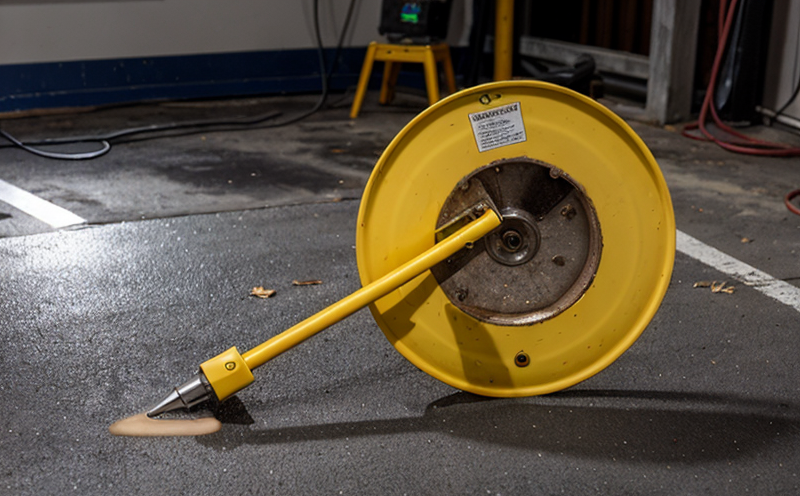ASTM E165 Liquid Penetrant Examination of AM Metallic Parts
The ASTM E165 standard provides a comprehensive approach to ensuring the integrity and quality of metallic parts produced through Additive Manufacturing (AM) processes. This non-destructive evaluation method is crucial for identifying surface defects in metal components, which can significantly impact their performance and safety.
During AM, layers of material are added incrementally to form a three-dimensional object using technologies such as laser sintering or electron beam melting. The process can introduce various types of defects that may not be visible through visual inspection alone. These defects include porosity, cracks, and other surface irregularities that could compromise the structural integrity of parts.
The ASTM E165 liquid penetrant testing (LPT) method is particularly effective for detecting these surface flaws. The test involves applying a penetrating liquid to the surface of the part, allowing it to seep into any open defects present on the surface. After a specified dwell time, excess penetrant is removed from the surface using a solvent. A developer is then applied to draw out the penetrant from the defect openings, making them visible.
The use of ASTM E165 LPT ensures that parts meet critical quality requirements before they are integrated into larger assemblies or deployed in applications where reliability and safety are paramount. This method provides a reliable way to assess the integrity of AM metallic parts without altering their physical properties or compromising performance.
By adhering to ASTM E165, laboratories can offer a standardized testing protocol that is recognized globally, ensuring consistent results across different facilities and jurisdictions. This standardization is essential for maintaining high-quality standards in AM processes and contributing to the overall trustworthiness of additive manufacturing technology.
The ASTM E165 LPT process is not just a regulatory requirement but also a practical tool for quality assurance. It helps ensure that parts meet critical specifications, thereby reducing the risk of failure and enhancing product reliability. This method is particularly valuable in sectors such as aerospace, automotive, and medical devices where the integrity of components can have significant safety implications.
Quality managers, compliance officers, R&D engineers, and procurement professionals all benefit from this testing methodology. It provides a clear pathway to identifying and addressing potential issues early in the manufacturing process, which is crucial for maintaining high-quality standards across different sectors.
Customer Impact and Satisfaction
The ASTM E165 LPT method plays a vital role in enhancing customer satisfaction by ensuring the quality and reliability of AM parts. This testing process not only meets regulatory requirements but also provides peace of mind to customers knowing that their products are free from surface defects.
For aerospace companies, for instance, ensuring the integrity of components through ASTM E165 LPT can be a deciding factor in meeting stringent safety standards. Similarly, automotive manufacturers rely on this method to ensure the reliability and performance of critical parts. In the medical device industry, the use of this non-destructive evaluation ensures that implants and devices are safe for patient use.
The ability to identify defects early through ASTM E165 LPT can significantly reduce the risk of product failures in the field. This not only improves customer satisfaction but also enhances brand reputation by delivering high-quality products consistently.
Competitive Advantage and Market Impact
The use of ASTM E165 LPT can provide a significant competitive advantage in the market. By ensuring that AM parts meet the highest quality standards, laboratories and manufacturers can differentiate themselves from competitors who may not adhere to such rigorous testing protocols.
In today's highly competitive industries, where customer trust and product reliability are paramount, compliance with ASTM E165 LPT is a key differentiator. This method helps in building strong relationships with customers by providing them with confidence that the products they receive meet or exceed industry standards.
The global nature of this standard also allows companies to expand into new markets more easily. By ensuring that all parts adhere to ASTM E165, manufacturers can enter international markets without facing additional regulatory hurdles, thereby opening up new opportunities for growth and expansion.
Why Choose This Test
- Rapid Inspection: The ASTM E165 LPT method allows for quick inspection of parts, enabling rapid identification and rectification of defects.
- No Destructive Impact: Unlike some other testing methods, this non-destructive evaluation ensures that the integrity of the part is not compromised during testing.
- Global Standard: By adhering to ASTM E165, laboratories ensure compliance with an internationally recognized standard, enhancing credibility and reliability.
- Early Defect Detection: This method detects surface flaws early in the manufacturing process, preventing costly errors downstream.
- Cost-Effective: By identifying defects early, this testing can save significant costs associated with rework or replacement of defective parts.
- Regulatory Compliance: Ensuring that all AM parts meet regulatory standards is crucial for compliance and market access.





